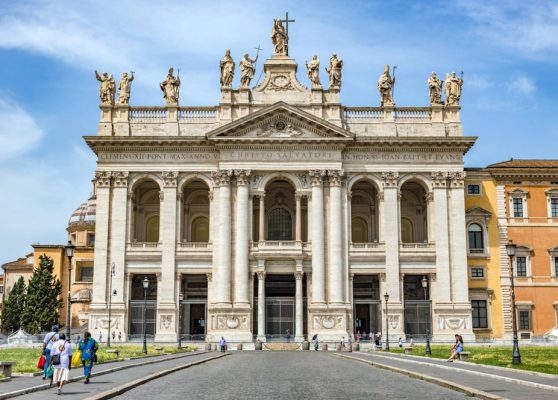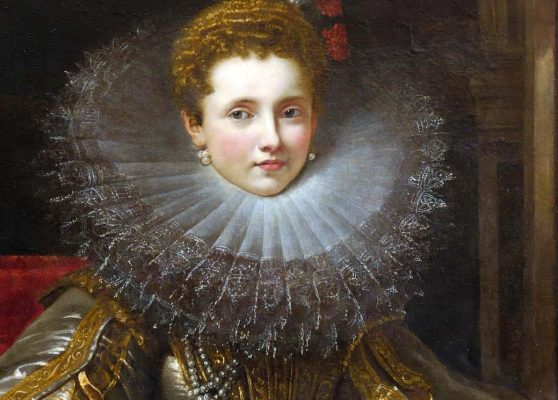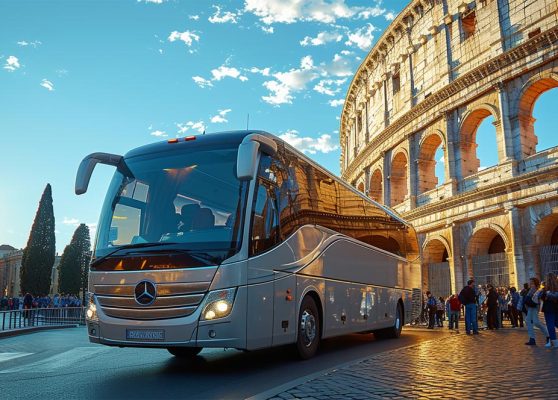Basilica of St. John in Lateran
The Basilica of St. John in Lateran (San Giovanni in Laterano) is the oldest of the four main basilicas of the Eternal City. It is the cathedral of the Diocese of Rome and the official ecclesiastical seat of the Pope.
Made in: 4th century AD.
Architects: Domenico Fontana, Giacomo della Porta, Francesco Borromini, Alessandro Galilei
Where is it: Piazza San Giovanni in Laterano

“Omnium urbis et orbis Ecclesiarum Mater et Caput. The Mother of all the Churches of Rome and of the world ” . Thus is known the Papal Archbasilica of San Giovanni in Laterano , the cathedral church of Rome and the official ecclesiastical seat of the Bishop, the Pope.
Flanked by saints and doctors of the Church, a 7 meter high statue of Christ stands out against the sky triumphantly showing the Cross of the Redemption. Here is the cradle of our religious heritage. Built by Constantine the Great in the 4th century AD, San Giovanni in Laterano is the first of the four major basilicas in Rome and the oldest in Christianity.
With the Edict of Milan (313) Constantine decreed the end of the bloody persecutions by promulgating the freedom of Christians with legal recognition. The Emperor gave Pope Melchiade (311-314) the land on Mount Celio , previously owned by the patrician family of the Lateran , to build a domus ecclesia .
The cathedral was dedicated to the Savior in 318. It was adorned with splendid friezes including seven silver altars with seven gold candelabra inlaid with portraits of prophets. Constantine also built the Baptistery on the northwestern corner of the church, which still continues to stand in its original design.
The Basilica was consecrated in 324 by Melchiade’s successor, Pope Sylvester I , and dedicated, by the will of the Emperor, to the Most Holy Christ the Savior .
In the 9th century, Sergius III also dedicated it to St. John the Baptist , while in the 12th century Pope Lucius II (1144-1145) also added St. John the Evangelist . The Lateran Palace , known as the Patriarchate , was the official residence of the Pope until the 15th century.
In the Liber Pontificalis all the huge donations that the popes and many benefactors have given to the basilica are recorded. In the first centuries after its construction, its splendor was so sumptuous that it earned the fame of “Basilica Aurea” , or the Golden Basilica.
Unfortunately, in the course of its history, such pomp has attracted invading vandals (Genseric in 408 and Alaric 455) that they plundered it of all its treasures.
Subsequent reconstructions were made by Pope Leo the Great (440-461) first and by Pope Adrian (772-795) later. The earthquake in 896 destroyed it almost entirely before being restored again by Pope Sergio III (904-911). Later the church was heavily damaged by a fire in 1308 and 1360.

The basilica has five doors in the narthex, one for each nave, punctuated by massive columns supporting monumental arches. The central bronze doors are Roman originals from the Curia (Senate) in the Imperial Forums . The rightmost door is the Holy Door which is open only during the Holy Year (once every 25 years).
In front of the left wall of the narthex there is the statue of the Emperor Constantine. The twelve enormous niches that Francesco Borromini created in the columns of the central nave enclose majestic marble statues of Apostles and Evangelists .
Despite the rigorous restructuring of Borromini, some historical testimonies still remain visible. In particular, the magnificent floor in the Cosmatesque style and the gilded wooden ceiling, made by Giacomo della Porta based on a design by his patron, Michelangelo .
Returning from their exile in Avignon , France (1304-1377), the Popes found the deserted city and their basilica and palace so destroyed. Inevitable was the decision to transfer the headquarters to the Vatican , near St. Peter’s .
The definitive restructuring of the current church was commissioned by Pope Sixtus V who entrusted the work to his favorite architect Domenico Fontana. A further interior intervention was carried out by Francesco Borromini for Pope Innocent X (1644-1655).
Separated from the basilica is the Baptistery , the first in Rome. Its current octagonal shape was created during the pontificate of Pope Sixtus III and was sampled by many other baptisteries.

Events you don't want to miss

Tourist transfer services

Chauffeur Service
Basilica of St. John in Lateran: your opinions and comments
Have you visited this monument? What does it mean to you? What advice would you give to a tourist?
Tours
The Omnia Card is a box that includes the Roma Pass 72h and allows you to visit, in...
Explore Ancient Rome with access to the Colosseum, Roman Forum, and Palatine Hill. Includes an audio guide app...
Book your Colosseum, Roman Forum & Palatine Hill ticket with audio guide and explore Rome’s top archaeological sites...
Secure fast-track entry to Rome's Pantheon with pre-booked tickets. Skip long lines and explore at your own pace...
This article was helpful, but some information for citing would make it better, but as it was not written to be a research article it makes sense.